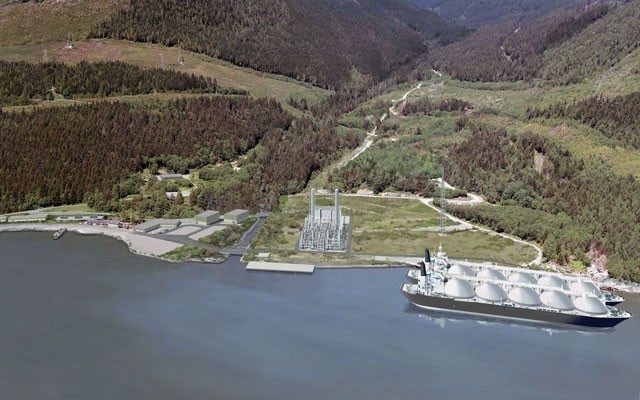Woodfibre LNG is going forward with its plans to build a liquefied natural gas facility on Howe Sound despite the recent cancellation of another LNG plant in B.C.
"We're absolutely moving forward with our project," said Woodfibre spokesperson Jennifer Siddon.
Her pledge comes a week after Petronas — a Malaysian-based company that hoped to build a $11.6 billion facility just south of Prince Rupert — announced that it was pulling the plug on its project, leaving many to wonder whether Woodfibre faced the same fate.
According to Siddon, the projects differ in critical ways.
At an estimated $1.6 billion, Woodfibre LNG — which will sit on the former Woodfibre pulp mill site near Squamish — is a far smaller and less expensive project than Petronas', said Siddon.
The site, she added, is zoned for industrial use and boasts a deep-water port.
It also has easy access to hydro and a pre-existing natural gas pipeline, which runs under it — though it will have to be twinned.
In contrast, Petronas needed to build its own port, a far more costly and politically sensitive endeavour.
Siddon said that while economic conditions are "challenging," the company has already secured a deal with a Chinese company to buy half of Woodfibre's annual LNG output, which will amount to 2.1 million tonnes per year.
Woodfibre LNG, however, continues to face strong opposition, particularly from environmental groups that view greenhouse-gas emitting LNG as a step in the wrong direction.
"This plant is going to produce 142,000 tones of greenhouse gasses every year," said Eoin Finn, director of research for Squamish community group My Sea to Sky. Added to this output are the emissions of the actual product from Woodfibre, which will add somewhere around 800,000 tonnes a year into the atmosphere, said Finn.
He also feels the facility, which will feature a large smokestack visible from the Sea to Sky highway, is an eyesore and is "quite at odds with image of Squamish as the outdoor recreational centre of Canada."
Finn said he fears the company, which was recently granted a 40-year export license from the National Energy Board, will simply wait things out, delaying construction until LNG prices rise.
He wants to see the regional governments come together to kybosh the project and instead encourage tourism and light industry.
One of the greatest obstacles for the project moving forward, however, may be the Squamish First Nation.
The proposed plant lies on Squamish Nation's traditional territory, and though Woodfibre has worked closely with the First Nation since 2013, and achieved an important environmental agreement, the parties have not struck a revenue-sharing agreement.
"Woodfibre is looking at a very thin business case to start with. By the time they parse out profits to the Squamish First Nation, there may be nothing left to make doing this project worthwhile," said Finn.
Under former Liberal premier Christy Clark, LNG was once touted as an economic saviour for B.C., an industry that would put thousands to work and fill government coffers with hundreds of billions of dollars.
Clark's bullish predictions, however, have not materialized, as the price of LNG has dropped and production has increased.
The current NDP government also backs the development of LNG, though the Green Party opposes it.
According to Kevin Hanna, director of the UBC Centre for Environmental Assessment Research, LNG will likely rebound in the future.
LNG is a good alternative to coal, and many developing countries will embrace it going forward, explained Hanna.
Of the projects that have been proposed over the years (there are 20 in total), he thinks the Woodfibre's is the most viable.
"It's a safe bet to say it will be built and up and operational in a reasonable time frame," he said.




